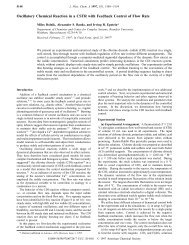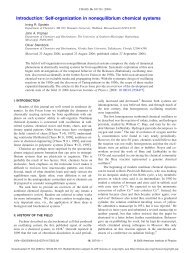Nonlinear Chemical Dynamics: Oscillations, Patterns, and Chaos
Nonlinear Chemical Dynamics: Oscillations, Patterns, and Chaos
Nonlinear Chemical Dynamics: Oscillations, Patterns, and Chaos
Create successful ePaper yourself
Turn your PDF publications into a flip-book with our unique Google optimized e-Paper software.
<strong>Nonlinear</strong> <strong>Chemical</strong> <strong>Dynamics</strong> J. Phys. Chem., Vol. 100, No. 31, 1996 13137<br />
Figure 7. Compound oscillation in the bromate-chlorite-iodide<br />
reaction. [I - ] 0 ) 4 × 10 -4 M, other concentrations as in Figure 5.<br />
Reprinted from ref 64.<br />
Figure 5. Dynamical phase diagram of the bromate-chlorite-iodide<br />
reaction in a CSTR in the k 0(flow rate) - [I - ] 0 plane. Fixed inflow<br />
concentrations: [BrO 3- ] 0 ) 2.5 × 10 -3 M, [ClO 2- ] 0 ) 1.0 × 10 -4 M,<br />
[H 2SO 4] 0 ) 0.75 M. Symbols: open circles, low-frequency oscillatory<br />
state; filled circles, high-frequency oscillatory state; open triangles, low<br />
potential stationary state; filled triangles, high potential stationary state;<br />
open squares, intermediate potential stationary state. Combinations of<br />
two symbols imply bistability between the corresponding states.<br />
Reprinted from ref 64.<br />
Figure 6. Traces of Pt electrode potential in a physically coupled BZ<br />
oscillator experiment. Bottom trace is potential V1 from reactor 1; upper<br />
trace is potential V2 from reactor 2 shifted up by 200 mV. 0-5 min:<br />
out-of-phase entrainment, coupling strength F ) 0.5; 5-11 min: steady<br />
state I, F ) 0.75. Coupling is switched off from 11 min to 11 min 40<br />
s. 11.7-19.5 min: steady state II, F ) 0.75; 19.5-22.5 min: steady<br />
state II, F ) 0.65; 22.5-36 min: out-of-phase entrainment, F ) 0.56.<br />
Reprinted from ref 68.<br />
What sorts of behavior do coupled systems exhibit? One<br />
frequently observed phenomenon is entrainment, in which two<br />
coupled oscillators adapt their motion to one another so that<br />
they oscillate with the same frequency or with frequencies that<br />
are related by a small whole number ratio. Figure 6 shows an<br />
example of 1:1 entrainment in a physically coupled system<br />
consisting of the BZ reaction run in two CSTRs that share a<br />
common wall with an adjustable diaphragm that permits<br />
variation of the flow between the reactors, which serves as the<br />
coupling strength parameter. 68<br />
We observe in Figure 6 that the two oscillators are entrained<br />
out of phase with one another: reactor 1 reaches a maximum<br />
in redox potential when reactor 2 is at a minimum. At a<br />
somewhat higher coupling strength, the two reactors become<br />
entrained in phase. Any pair of physically coupled oscillators<br />
must approach in-phase entrainment as the coupling approaches<br />
infinity, since in this limit the two reactors become one. More<br />
interesting, <strong>and</strong> perhaps surprising, is the fact that the system<br />
exhibits hysteresis. As the coupling strength is decreased, the<br />
in-phase mode persists through coupling strengths at which the<br />
out-of-phase mode is stable. This behavior is an example of<br />
birhythmicity, bistability between two oscillatory states, a<br />
phenomenon that is often seen in systems of coupled oscillators.<br />
Many forms of multistability occur in chemically coupled<br />
systems. The bromate-chlorite-iodide reaction exhibits birhythmicity<br />
between two oscillatory modes, each of which<br />
resembles in wave form <strong>and</strong> mean potential the oscillations seen<br />
in one of the component systems. 64 The chlorite-iodidearsenite-iodate<br />
reaction shows tristability among three steady<br />
states in a CSTR, 69 while the chlorite-thiosulfate-iodideiodine<br />
system has another kind of tristability involving one<br />
oscillatory <strong>and</strong> two stationary states. 70<br />
In addition to birhythmicity, two different modes of oscillation<br />
can interact in such a way as to give rise to compound<br />
oscillation, in which the two wave forms merge to give a single<br />
complex periodic mode. An example of compound oscillation<br />
in the bromate-chlorite-iodide chemically coupled system is<br />
shown in Figure 7. Under these particular conditions, as the<br />
flow rate is changed from a region where only one mode of<br />
oscillation exists to a region where only the other mode is stable,<br />
instead of either a sharp transition between modes or a<br />
coexistence (birhythmicity) of the two, the limit cycles merge<br />
to form a single large-amplitude oscillation that has characteristics<br />
of both oscillatory subsystems.<br />
Two other phenomena that occur in coupled oscillators are<br />
worthy of note. Oscillator death is the term given to a transition<br />
to stationary behavior when two oscillators are linked together.<br />
An example is shown in Figure 6 when the coupling, measured<br />
as the ratio of the flow between reactors to the flow through<br />
each reactor, is set at F ) 0.75. Even though each reactor would<br />
oscillate in the absence of coupling, the coupled system reaches<br />
a stable steady state in which one reactor is at a high potential<br />
<strong>and</strong> the other at a low one. By turning off the coupling for<br />
about half a period of oscillation for the uncoupled system, we<br />
cause the system to travel halfway around its orbit <strong>and</strong> to<br />
become locked in a complementary steady state when the<br />
coupling is reinstated.<br />
Just as coupling can cause oscillators to cease oscillating, it<br />
can induce oscillation in systems that show only steady state<br />
behavior when uncoupled. This phenomenon is known as<br />
rhythmogenesis <strong>and</strong> was first demonstrated experimentally in<br />
the chlorite-iodide reaction by Boukalouch et al., 71 who<br />
physically coupled two CSTRs containing the system in the<br />
reduced <strong>and</strong> oxidized steady states <strong>and</strong> observed periodic<br />
oscillation in both subsystems at appropriate values of the<br />
coupling strength.<br />
Although we have focused on results for pairs of coupled<br />
subsystems, it is possible to study coupled systems with larger<br />
numbers of elements. Laplante <strong>and</strong> Erneux 72 have studied the<br />
propagation of the transition between bistable steady states in<br />
the chlorite-iodide reaction in a system of 16 linearly coupled<br />
CSTRs. More recently, a system of eight of these units has





